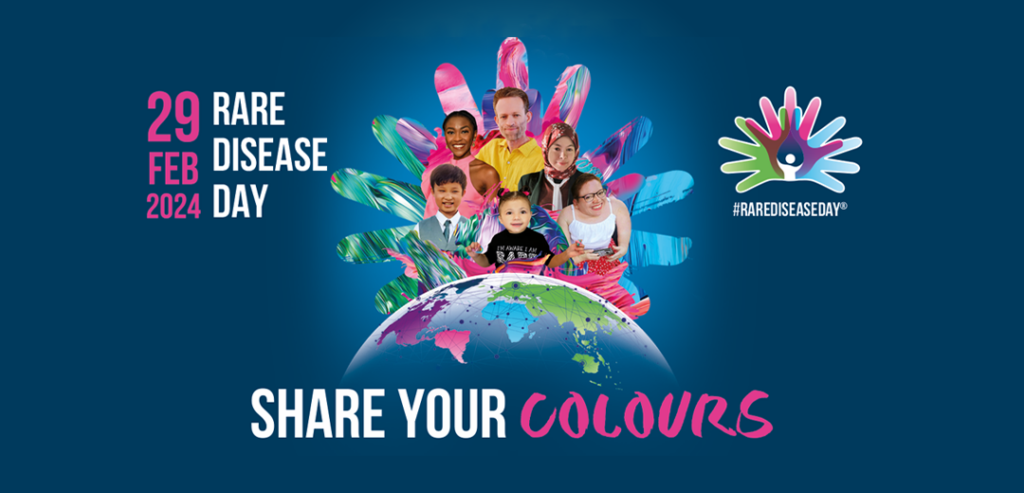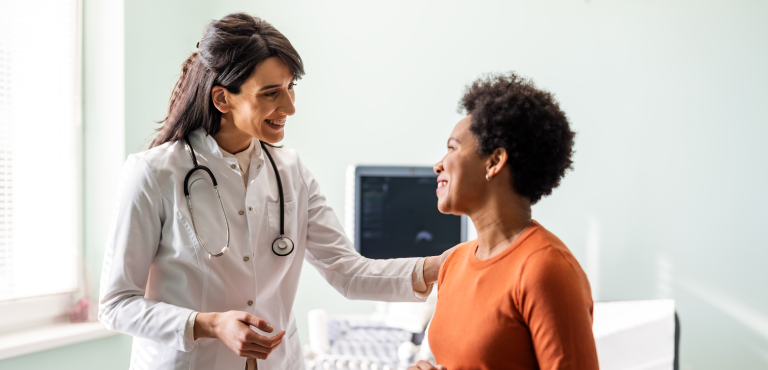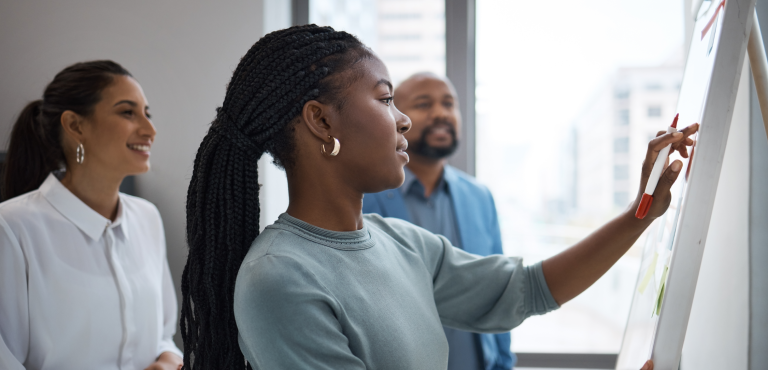Rare Disease Day takes place annually on the last day of February (the rarest day in the calendar on leap years) and is a global patient-led movement aiming to raise awareness of rare diseases.
This blog explores my rare disease experience and highlights the importance of raising awareness and improving the experiences of 300 million people living with a rare disease worldwide.
My diagnosis
It’s 2015, and I’m talking to my parents in the living room when the stripey wallpaper starts moving. It was so distracting that I couldn’t focus on what was being said; instead, I wondered, “What’s in my drink!?” A quick Google confirmed that this wasn’t normal and that I should seek medical advice, so I booked an appointment at the opticians the following day and tried to keep calm.
The optometrist confirmed that she could see inflammation and fluid at the back of one of my eyes, which explained my symptoms. She understood my worries and explained that the hospital had better knowledge of the causes of this type of visual distortion and more advanced scans so they could offer treatment and continue my care. You know it’s serious when you leave with a letter to take to the eye hospital’s emergency department immediately!
The next day, I went to the eye hospital and had multiple tests and scans. Despite the urgency, I wasn’t properly informed about what was happening or the severity, so I didn’t initially take the symptoms seriously. For context, I was a 22-year-old single Mum of two, working part-time in a supermarket. I told myself, “Trust the professionals; they’ll guide you”. However, by the time of my third injection of inflammatory medicine to the back of my left eye (known as the macular), around three months after the initial symptoms, I’d still only been flippantly told I likely had juvenile macular degeneration and wasn’t informed on what this meant.
So, I tried to get more information when I was next at the eye hospital. What exactly was I being treated for? What was the prognosis? How many appointments would I need, and for how long? These were just a fraction of the questions plaguing my mind, but I felt I only had time to prioritise the most urgent answers. I was simply told by the doctor, “You have a secondary condition because of a primary condition, which requires prompt treatment to rescue your vision” This response left me feeling terrified for my future and with twice as many questions!

Once my first flare up had calmed, I missed follow-up appointments due to work and childcare commitments; I had a blasé outlook on my visual health and stuck to the narrative of “if it’s that important, the doctors would have explicitly said so”.
Over a year after my first flare, I finally had my first consultation with a uveitis specialist. She explained that I have a rare variety of a condition called uveitis, which causes inflammation in the eye. This type is called Punctate Inner Choroidopathy (PIC), with a secondary Choroidal Neovascularisation (CNV) diagnosis. This complicates things by causing blood vessels to leak during a PIC flare-up. She highlighted the importance of monitoring my symptoms and attending routine appointments. She also emphasised that if changes in my vision occurred, I needed to go to the eye hospital’s emergency department immediately to receive emergency treatment.
I asked if I could do anything to reduce the occurrence of flares, but she said so little is known about this rare condition; even specialists can’t confidently say whether the immune system, hormones, stress or a combination influences it.
Adjusting to life changes & medication side effects
Fast forward to 2019, the year I received a diagnosis in what was once my good eye. Following the advice of my consultant, I immediately attended the emergency department when I noticed changes in my vision. The symptoms were bad enough that my driving license was revoked at the start of my driving test. However, the staff dismissed my concerns and sent me home. I felt overlooked, deflated and without treatment. Later that day, the eye hospital called me back in a panic and urgently squeezed me in for emergency treatment. They’d liaised with my consultant, who’d verified what I’d already told them. This whole experience made me feel distressed and anxious for when the need to attend the emergency department again arose.
Typical preventive treatment consists of immunosuppressive therapy to reduce the risk of a flare, steroids to reduce general inflammation, and eye injections of a medication that was not officially approved for treating my condition to reduce inflammation inside the eye. However, I wasn’t offered preventative treatment until four years after my initial symptoms presented.
As happy as I was to have a treatment plan, this was only the beginning of what would be a difficult few years. Not only did I need to adapt to relying heavily on my peripheral vision, but I also had to take 24 tablets every single day – most of which came with side effects which negatively impacted my quality of life.
On the one hand, I’m pushing spoonfuls of baby food into my daughter’s cheek because I can’t see her mouth. On the other, the medication that should help has resulted in me gaining weight, struggling with my mental health, having inflammatory bowel disease and a considerable tremor. The emotional impact of trying to treat a rare condition is something I struggle to find words to describe. Stuck between a rock and a hard place is the best way I can describe this feeling; minimal options result in feeling like you must choose between symptoms and side effects.
Finding community
I’m forever grateful that I was advised to join a patient support group which includes patients from around the world with the same condition as me. Through this group, I connected with the charity Macular Society members, who asked me to take over their Instagram during Macular Week in 2021 to share snippets of life with a macular condition! I also found another group of wider juvenile sight loss community members.
These communities welcoming me with open arms helped to manage the growing anxiety around my eye health and vision; they helped me to feel less alone. I found that the patients in the group were not only experts but also understood my concerns and took the time to share tips on vision impairment. The group taught me the importance of self-advocating when living with a rare disease and provided general support. The wider sight loss group also helped me recognise my privilege; despite having minimal options, I had some, which isn’t always a given.
Advocating for yourself with a rare disease
After a year and a half of shielding during the COVID-19 pandemic, my mental health reached breaking point; I seemed unemployable, I felt like I was living my life around the disease, and something had to give.
By this point, I’d had countless injections in both eyes, introduced a second immunosuppressant, had a steroid implant in my eye, which had induced hypertension, and I’d been on oral steroids for years. Yet, whatever approach was taken to wean me off the oral steroids, a flare would trigger, and it was back to square one.
Speaking to members of the PIC support group, I learnt that there were approaches to coming off steroids that my team hadn’t tried, and there was another treatment option I could try. It wasn’t a miracle solution, but I felt it was worth a shot. Equipped with this new information, I felt empowered to tell my consultant how I felt and that I wanted to try a different approach. This was met with resistance on multiple occasions until (again, with the advice and advocacy of the support group) I sought a second opinion from a PIC specialist at The Centre for Rare Diseases in Birmingham. The professor there agreed with what I was requesting and wrote to my primary consultant, outlining his recommendations, which were eventually decided upon by my usual eye care team.
Present day
Despite permanent damage, my vision has remained stable for around 18 months, and I managed to swap the 24 tablets a day for one injection every two weeks. I’m halfway through my first year of a degree apprenticeship, where I attend university alongside working a full-time job. I have a career ahead of me fuelled by my rare disease experiences; I’m a User Experience Research Apprentice focussing on improving accessibility for patients worldwide. My life feels mostly ‘normal’ again.
Global movements like Rare Disease Day are vital to shed some light on the conditions which otherwise leave patients living in the shadows and isolated by their health. These initiatives put a focus on the importance of open conversations. Had it not been for groups of strangers on the internet feeling brave enough to share their stories, I would not be where I am today. I’ll always wholeheartedly encourage anyone with lived experience of a rare disease to speak up about it and get involved in rare disease day however you feel comfortable, even if it helps one person – it’s worth it.









